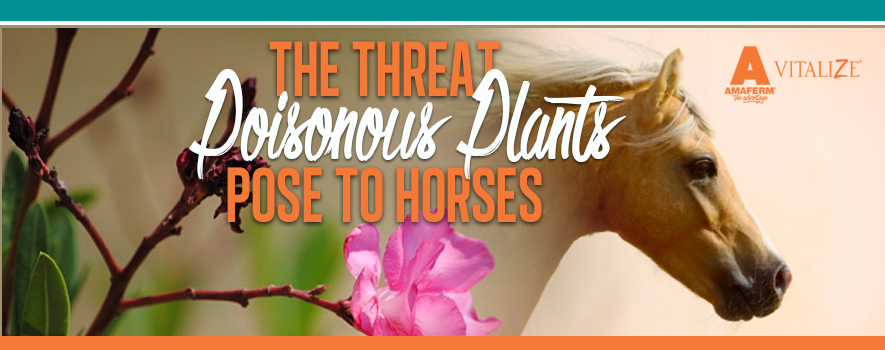Poisonous plants can be a big threat to horses, especially those who spend time in large pastures or get loose and find themselves in your landscaping! Below are some of the most common poisonous plants for horses. The toxicity of each of these plants is dependent upon the amount consumed, the part of the plant that is consumed, and even the time of year it is consumed.
Oleander is one of the most toxic plants to horses. Just a few bites can kill a horse within minutes of consumption. Oleander is toxic to humans, too. It is often found in southern and coastal landscapes and has beautiful (but deadly!) fragrant pink flowers.
Hemlock is another extremely toxic plant to both horses and humans. It is a weed that can be identified by purple mottling on the stem. Poisonous hemlock is widely distributed across the United States. However, it gives off a foul smell when crushed and tastes bad, so horses will rarely consume it.
Yew is a shrub or small tree sometimes found in landscaping. It is an evergreen with soft needles. Female plants have berries that become a rich red color in the fall. It is highly toxic to horses and is generally found in the south and along the coasts.
Buttercup is bright yellow flowering plant that is often found in pastures throughout North America. Consumption of buttercup toxin can cause blisters on the horse’s lips. However, horses generally avoid buttercup due to its bitter taste.
Horsetail is a fern-like plant that is sometimes found in pastures in North America that has a small, scaled cone of spores around its top. It is toxic to horses, but high doses must be consumed for a detrimental effect to occur. For this reason, horsetail in large grazing pastures is not a big concern. However, toxicity often arises when horsetails are baled in hay.
Bracken Fern is another plant that is only toxic to horses in large doses. It is also found throughout North America, but prefers temperate climates. Bracken Fern is not often consumed in enough quantity to cause toxicity, but, if it is, it is one of the few poisonings that has an easy cure in horses.
Milkweed plants vary in their size and appearance, but all milkweed plants release a white, milky substance when the plant is injured. Milkweeds are fairly toxic to horses with as little as one pound of consumption causing severe symptoms or death.
Sudan grass and Johnson grass are two types of grasses that contain a cyanide compound that is toxic to horses. These are tall, coarse-stemmed grasses with big leaves and large seed heads.
Locoweed is a perennial with short stems and no leaves. They often have purple or white flowers and are found in western and southwestern parts of the United States. Horses with mild poisoning will recover without treatment.
Tansy ragwort is a weed with multiple stems per plant that produces small yellow flowers. They are found throughout the United States and cause liver failure after prolonged consumption. However, horses must consume upwards of 50 to 100 pounds before toxicity occurs.
Red Maple trees are primarily found in eastern North American, but have a range that extends into the west as well. They have green leaves in the spring and summer and rich red colored leaves in the fall. Most of the time Red Maples are not toxic. However, when the leaves wilt (for example, after a branch falls from the tree), they become very toxic if consumed.
Black walnut trees are tall trees that grow throughout the eastern portion of the United States. It is one of the few plants that is toxic to horses when it is not consumed. Instead, it often causes toxicity when the horse’s hooves come into contact with parts of the tree. This is usually because the wood shavings used for the horse contain some small amount of black walnut.
Other examples of plants that can be poisonous to horses include: Russian knapweed, yellow star thistle, nightshade, poke weed, wild cherry, and azalea. If you suspect your horse has eaten a toxic plant, call your veterinarian immediately.


